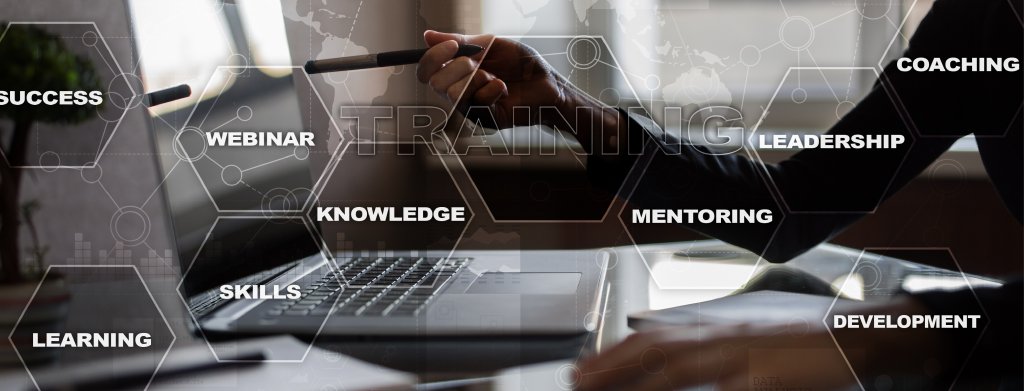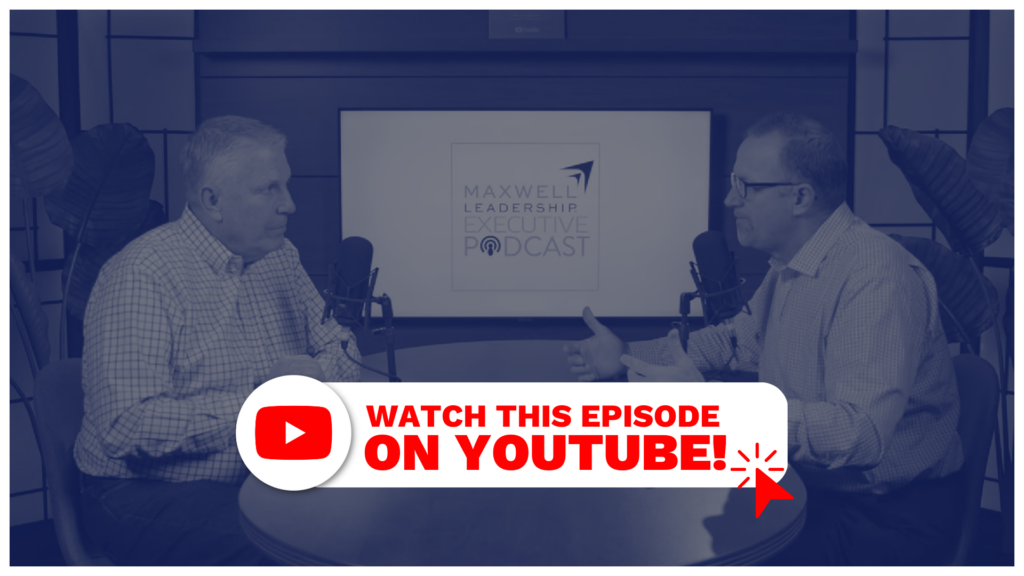Executive Podcast #304: Building a Professional Development Program

In this episode, Chris Goede and Perry Holley share valuable insights on developing a professional development program for organizations. They walk through nine key components to consider when creating a program, including assessing organizational needs, evaluating employee self-assessments, and developing a strategy. Throughout the episode, they offer practical advice and real-world examples to help leaders implement an effective professional development program in their own organizations.
This episode is sponsored by Visit Orlando. Whether for business or entertainment, visit Orlando, where the possibilities for business travel are unbelievably real!
References:
Order John Maxwell’s new book High Road Leadership!
Become a Maxwell Leadership Certified Team Member!
Get the Maxwell Leadership Growth Plan!
Download our Learner Guide for this podcast!
Chris Goede:
Hey, listeners, Chris Goede here with some bonus business insight before we jump into today’s episode. If you’re looking for the right place to host your next business gathering, conference or event, look no further than Orlando, Florida. It’s no coincidence that Maxwell leadership hosts our biannual international Maxwell Conference in Orlando. Between its many luxurious hotels, meeting spaces and venues, Orlando is the perfect place for you and your team to gather, collaborate and grow. Whether you’re traveling for business or bringing your company for a meeting, there’s a reason Orlando is as much a business capital as an entertainment one. And let’s not forget the delicious cuisine at one of the many Michelin rated restaurants where your team can kick off your evenings. So before you plan your next business event, check out Orlando, where the possibilities for business travel are unbelievably real.
Chris Goede:
Learn more at orlandoforbusiness.com.
Perry Holley:
Welcome to the Maxwell Leadership executive podcast, where our goal is to help you increase your reputation as a leader, your ability to influence others, and your ability to fully engage your team to deliver remarkable results. Hi, I’m Perry Holley, a Maxwell leadership facilitator and coach.
Chris Goede:
And I’m Chris Goede, executive vice president with Maxwell leadership. Welcome and thank you for joining. As we get started, I want to remind you, please visit maxwellleadership.com/podcast. There you can learn a little bit more about the five levels of leadership 360, some content that Perry has written that we helped teams walk through, some coaching, which is ironic. A lot of our conversations come from feedback that we get around some of the coaching things, not only from you, but from some of our other coaches that are out there in the field as well. And so if you visit there, click on this podcast, you’ll be able to fill out a form and we’ll get back in touch with you. Well, I am looking forward to today and the topic, because this is what we do, this is what you and I wake up every day and we think about. And we’re going to talk about building a professional development program.
Chris Goede:
And with Perry’s experience and being in the, we always call it the l and D world, the learning and development world, the content creation now heavily for us on behalf of John and his pen and just the things that we’re going through and the plans like this is what we are passionate about. And so we’re going to talk a little about it. So excited to see that. What burdens us is that we have the opportunity to work with a lot of organizations, and it’s almost kind of like the first time they’ve ever heard of it.
Perry Holley:
That’s actually where the idea came from.
Chris Goede:
Like, what, what is this? And then leaders end up being complete reactionary, and, um, they, they bring in different types of training. I always talk about, too, that where if you begin to, well, you know, off the shelf here this and off the shelf here for that and that problem, depending on what you’re dealing with and what season you’re in now you got all these languages and philosophies. And so, man, it’s really good to step back. And so we’re going to talk about step back and look at how do you develop a leadership development or a professional development plan for your organization? How do you be proactive about that now that we’re excited about it? Because it’s what we do. But we’ve talked about this before, too, especially with the millennials and the Gen Z’s. When you look at the top five reasons on why they’re picking organizations, the number two reason is what is the career development and growth opportunity for me in that organization? And I know personally for myself, if, if I went into an organization and I was negotiating, we were down to the table and they said, look, we just, we developed this professional development plan. This is what it’s going to look like for the next twelve or 18 months. I’m like, sign me up.
Chris Goede:
So we’re going to dive into the importance of this, how to do it, and give you just some insights behind our experience with it.
Perry Holley:
Well, as you said, it came from a lot of coaching conversations and working with clients at their locations. Maybe we’re delivering a workshop and they don’t have a cohesive plan, and it’s kind of one off here, one off there, and they’re working and doing the best they can. I just, like you said, though, I think having a plan, and this was a little bit of an experiment, was in a room and one of our colleagues, Dana MacArthur, and he said, you know what? I’m gonna do an extra around level four and the five levels workshop, which.
Chris Goede:
Doesn’T surprise me about Dana when he’s facilitating for our clients. It’s like you never know where he’s.
Perry Holley:
Gonna take the room. Nothing’s off the table. He just asked the audience to at their tables. You’re being tasked with developing your own personal professional development program for your, either department, for your company, for your team, whatever your, whatever your group is, what would you want to have in it? Why is it important to the team? What are the components? What are the key principles you want to offer that type of thing. And so I’m kind of rolling my eyes a little bit, but then it gets so energetic, and people really coming, just really out of their shoes with ideas and what they would do. And I thought, okay, this is. He’s on to something here. And then I’ve run it.
Perry Holley:
I ran it virtually a couple of weeks ago, just doing an exercise, one of the groups we coach, and they really responded well, too. So I thought, you know, I think I’ll just share this with our bigger audience, run through some of the components. How do you think about a development program? I do want to encourage. You don’t think this is some big, complex, audacious thing? It doesn’t have to be. It can be actually, the more simple, the better. And it can be very structurally thin if you need to be, and you can add to it as you go. But I think some people are shy away from it because it seems hard and it’s big, and we don’t have all that. No, we’ll go with what we have.
Perry Holley:
We’ll give you some ideas on that.
Chris Goede:
Well, I love what you just talked about, because, you know, if you confuse them, you’ll lose them. Right. I love your word, simple. Like, no, no, let’s keep this simple. And I love that idea. Um, there’s something that. To take from that as you go through this process is what is it that the end user wants? Right. Like, the energy created that, Dana.
Chris Goede:
And then you. And that coaching call is you got them to speak into it. So. And then the other thing is, I just want to make sure you guys make it very practical. Simple and practical. So let’s dive in. Uh, the first one that we have for you is assess the organizational needs. Right? So evaluate the company’s goals, the skill gaps, the future requirements of what you need to align, you know, some.
Chris Goede:
Some of your team members with. I love this statement where we. We tell people that have this in place, hey, go to that team member and say, this is what the organization is going to need from you in the future. We’ve looked at this. We know you have a skill set. We want to develop you for that. Lots of great, engaging conversations that can happen. But.
Chris Goede:
But you need to assess first. You can’t just come in and say, here’s what we’re doing. You can, but we would tell you to say, hey, take a step back first. We have a lot of assessments that we use, personal and organizational assessments, and it’s like going to the doctor’s office. Now, listen, my wife will tell me all the time. Doctor Chris, you might want to go get somebody else’s opinion before you ask for a prescription. Right? I’m like, no, no, this is what it is. And she just shakes her head, she’s a nurse by trade, and says, okay, doctor Chris, let me know when you get that.
Perry Holley:
Right.
Chris Goede:
So it’s the same thing with going to the doctors. You got to go there. You’re dealing with a lot with us right now, and you got to get a prescription. It’s the same thing with the development plan. Let’s make sure that we’re building something that prescribes to solve a problem or a goal or a future state that you’re looking for.
Perry Holley:
So you’re working with your business leaders across the. If you’re just doing it for a department, it’s a little easier. But if you’re doing it for the organization, what are the business needs? What are we trying to solve? You can’t just. You can’t say, we need leadership skills. Well, that’s a little broad. Which level of our leaders are we at? So you start to do this assessment. That’s very important. I think the second step of this is kind of evaluating a self assessment, having the employees or the team members or the unit assess themselves.
Perry Holley:
Where are they against these skills that you’ve identified? Now, my experience here is anytime you’re asking for self assessment, people tend to have a better view of themselves.
Chris Goede:
That’s a nice way to say it.
Perry Holley:
Yeah. Better. They may think they’re better than they really are. So this is a great leadership moment, too, to say for you as a leader. Do the people on your team know what their strengths and we are? Are you clear with them on your observations? Do you provide feedback to help them understand that this is a real opportunity for you to step up, to say, I want. We’re going to be going into this, this leadership development or this any development in your organization. Here’s the plan for you. It’s a great opportunity for you to lead by helping people identify gaps.
Perry Holley:
And I love we can train to the gaps. That’s what the whole thing’s about. But if you. If you assess, like you said, step one, these are the skill needs. We have to go into the future that we want. This is where our people are. Here’s the gap. You got to be really honest about where that.
Perry Holley:
Where they are or the gap looks too small. We’re trying to get. We do have a bigger gap in some areas than others, and I want to make sure we apply that.
Chris Goede:
And to that point. If you set the bar in the starting point a little bit too high, you’re going to discourage them. They’re not going to be able to keep up. And so I love that that’s where you’re guiding us to start on this professional development plan. Number three, develop the strategy behind it. What does that look like? What’s the plan? What are the activities? How much coaching is involved? What are the courses? How do people like to learn? Right. We often ask a question when we’re talking with organizations is how do your people want to absorb content? Right. What does that look like? Do you want it to be in person? Do you want it to be virtual? Do you want it to be.
Chris Goede:
And so I want you to just step back and think about that. What is that strategy? What does that look like? How are we going to roll out this development plan? And then I just want, I want to, I want to set proper expectations for you. And this goes back to John’s law of the process and the 21 laws. Hey, it’s not going to fix itself in 15 days. We send Perry in sometimes and, well, he can fix some people about 24 hours, but it is a process and it is going to happen daily, not in a day. And I think really that’s one of the main reasons that we’ve seen such a high demand in the follow up coaching process from some of our trainings, whether it’s in the group or the one on one, because they know that it’s a process. So develop a strategy and just make sure that you give enough time to work itself out.
Perry Holley:
And there’s, this is such an important step is if you assess the skills that our organization or group needs, we’ve assessed where we are. We’ve identified the gap. Now how are we going to do that? And there are, technology gives you so many more options today than you’ve had in the past. So are we going to go into classrooms? Are we going to go online? Are we going to blend some blending of classroom and online? Are we going to do self study? It’s going to be asynchronous and they’re going to just go through it themselves. You’re going to the next one. Number four is provide resources. What are the budgets? What are the necessary resources, such as time, money, materials, those types of things you may have, I’ve done this with a number of organizations, severe limitations on what’s possible out of the gate of. But as you build over time, you start to budget for things.
Perry Holley:
You start to say, hey, it really be cool if we had a training room on site, maybe cool if we had some of our own materials that we could check out to people, like a library type of a situation. Or it may be really neat if we could bring in John Maxwell company and Perry Holly and come in on site. I mean, there’s different budget things, but resources. I’ll tell you one that we get a lot of pushback when you start to execute something like this is people say, I don’t have time. So allocating time, it may sound like nothing your job, but it is your job. Let people know this is a requirement and they need to either make the time, you’re going to allow the time, you’re going to schedule the time for them to execute on these strategies that you put in place, and by the.
Chris Goede:
Way, you’re paying them for that time. So it’s a resource that, in essence, that you are giving up and committing. And I promise you, I’ve seen it, you will get your return on investment with that.
Maxwell Leadership Certified Team:
Hey, podcast listeners, many of you listening right now would probably love the autonomy that comes with owning your own business or becoming a coach that helps other businesses succeed. Well, we have a phenomenal strategy where you are 100% in control of your own business, earning income on your own terms, and have access to the people, tools and resources you need to build a thriving leadership development business. When you become a Maxwell leadership certified team member, you join a global community of entrepreneurs led by our expert team of mentors and faculty, including John C. Maxwell. You’ll also get one of the top leadership certifications in the world next to your name, giving you the boost you need to get started. Visit us online at maxwellleadership.com/jointheteam to find out more.
Chris Goede:
The fifth item we want you to really focus on is how often are we checking in. What we don’t want you to do is develop a plan and then say, we’ll see you in 18 months. Because, you know, we’ve got to make sure. And Perry could speak to this a lot, right? Like we’re coaching one way, and then something happens. Individually, organizationally, we kind of move the needle a little bit right there and, and there’s continuous check in. So it’s a good old sales statement of what you measure, what you look at gets done most of the time. I always like to throw that in there because I’ve been there before. I’ve worked my way around some of those things as sales leaders.
Chris Goede:
But in order to really track progress, to make sure we’re making movement, have conversations, not only with the team members, but those that they report to. And what I love about this is pull some testimonies out, grab some of the things that the AH moments, because if Perry and I are considering something and Perry shoots me a text is like, hey, I just went through this and it really impacted me. Guess what I’m doing? I’m signing up for it. Well, I want to capture that and then put it out there because it’ll be something that. And you can only get those if you’re regularly checking in.
Perry Holley:
Yeah, good. So I worked for a fortune ten company for a lot of years. They had seemed like unlimited budgets for learning and development. We had the most sophisticated tools and tracking systems and execution of these strategies of learning and sending people off the classes. And they, they invoked the IDP, the individual development plan. So everybody in the company had to have an IDP and you had to go online and put in what you were going to do. Which of the strategies, which of the deliverables, what skills you were working on. It was highly elaborate and no one did it.
Perry Holley:
And I was upset as an individual contributor because I happened to take personal development very seriously. And I was like you said, somebody showed me, yeah, I’m in. That’s great. So I filled out mine. Nobody ever asked a question. Nobody ever looked at it. And then somebody at the top decided, hey, nobody’s ever asking questions. Nobody’s ever looking at it.
Perry Holley:
We want all the managers, you have to go in by January 15 and validate all IDP’s. Guess what? That became a tick the box exercise. Hey, make sure your IDP’s are up to date. Right? Are we going to talk about it? No. Are we going to execute it? No.
Chris Goede:
Just make sure they’re in there.
Perry Holley:
Just make sure it’s in the system. So this check in, find out, get feedback. Is this doing what we want it to do? Are people executing on this? What I did was I put it into. So I’m a big proponent of every leader having a one on one with people on their team, either every week or every other week, depending on your size of your team. Once a quarter, and I gave them heads up, once a quarter. Our one on one is going to talk about your development plan. So when we start early in the year, I want to see what it is. What are you committing to that you’re going to do? You’re going to read something, watch something, do something, get some skill, work on something.
Perry Holley:
And then I’m going, I’m. You’re going to file that? I’m going to see that, and then I’m going to ask you once a quarter, where are you with that? How are you doing? What else do you need to do? How can I help? And that little. It’s really a 15 minutes. I didn’t even use the whole one on one. I just. For the first 1015 minutes, we’re going to talk about your personal development plan. What are you doing?
Chris Goede:
It’s good.
Perry Holley:
How’s it working? And guess what? People started doing it.
Chris Goede:
Yeah.
Perry Holley:
They started saying, well, wow, he’s asking questions. It must be important. And that’s another great leader concept right there. The questions you asked tell people what’s important to you. So if you’re not asking, they’re not doing it. And if you’re asking, they’re going to find out that that’s, that that’s a big deal. Uh, I said number six was reward and, um, recognize progress. So it’s a little.
Perry Holley:
Gotta kind of play in on that. But celebrating achievements, letting people know that you got, matter of fact, if there are certifications or qualifications or ramifications involved, let people know that they, you know, they got a certificate, though. They let people know that others are doing. Like you said, when you see others begin to buy in and get that.
Chris Goede:
Hey, I want to be a part of contagious.
Perry Holley:
Right.
Chris Goede:
Building off the same theme, we want to make sure that you are working towards a continuous improvement. Right. So this is something to where, again, it’s a process. It’s over time. We often say, hey, we want to take you on a leadership journey. What does that look like? It’s not just one stop. Right. And so you go through, make it part of the.
Chris Goede:
Your performance review. I love Perry’s idea right there. You just gave me in a minute. Hey, dedicate one of your one on ones a quarter. The first part of it is say, let’s talk about this. Where are you at? What is going on? And then that way you can make some adjustments. Maybe the individual got a promotion or they’re struggling with something, or something came up that you can help adjust and make all of that. But the only way you can do that is if you’re continually looking at it and making sure that we’re improving the plan.
Perry Holley:
The idea of feedback and evaluation of the program, of what you’re doing. Have we kind of an AAR, an after action review to say, how are we doing with this? The aspects, are we clear about what the skills are that we need to have in our organization? Are we honest about the gaps that we have, are we allocating resources appropriately? Do we need more of this or less of that? The only way you can do that is honest feedback and evaluation. And the team has to be really looking at each other to say, this is what’s working, this is what’s not. What I have found is once you get on this journey, you start to see such positive results. From the attitude and outlook of the team, people began to realize that, as John tells us, growth does not happen by accident. You have to be intentional about these things. And I just love this idea of setting up a program. Make, keep it simple in the beginning.
Perry Holley:
Figure out what you need, the gap, how to get there, resources we can get over time and people will begin to get on board and take it seriously. But you got to be honest about the feedback on that.
Chris Goede:
And as your budget allows, I would also encourage you from a technology standpoint to involve that where you can. There are tons of third party technology organizations can help you. A lot of plugins, maybe some certain systems you have, and you can be able to track the progress of that. As you know, Perry said earlier, the fortune ten company, all the resources they were able to tell when he clicked and opened up a course and what he was doing. So make sure that as this is number nine, use technology right. Make it a part of it if you can. Like part of. Perry said, maybe you need to start small, but know that you’re going to be able to track and print reports and, and progress just like you do your, your financial reports.
Chris Goede:
You can make it as important as your finance reports of what’s going on inside your development plans. And you can use technology to be able to do that.
Perry Holley:
You can get very creative, uh, using technology and using other resources that we’ve heard us on this podcast recommend many times about. I was on a call this morning with a guy. He said, I’m gonna, I talk about it all the time. He said, I’m gonna do something. You told me. I go, oh, hey, thank you.
Chris Goede:
Yeah, like you. Twelve calls later, yeah, it was a long time.
Perry Holley:
But he said, I’m gonna do a book club as part of our development prop. We’re gonna go through a book together. I said, great, fantastic. It’s a start. Laying breadcrumbs to telling people that we’re going to develop ourselves. I will just mention before I turn it back to you to close, is that I’ve seen some challenges to. These is kind of the three biggest challenges I’ve seen. And they, we mentioned them a little bit, but not dedicating the time and being inconsistent.
Perry Holley:
So if you say we’re starting a program, and then they don’t hear from you for a month, and they say, we’re going to put this out, and then they don’t hear from me for a quarter, that it needs to be a drumbeat, it needs to be a constant, and that that inconsistency will tell people you’re not serious, and they’ll say, well, I’m not going to put the time on that because nobody else is doing that. Lack of self awareness, I mentioned that earlier. But helping people become more self aware of their actual strengths and weaknesses, helping them find their gaps, and that’s what we really do. We’re trying to fill gaps, help you to grow, to be more effective in the work that you do, and then just overall resistance to change. He says, you want me to do what? And now we’re starting something that brand new nobody. And why are we doing this? I don’t have time for this. Um, it really is, uh. Change can be a big, uh, obstacle sometimes.
Perry Holley:
But if you. If you’re serious and tell people the real reason why, they’ll usually find it. It’s really for them. It’s to help them be better.
Chris Goede:
100% it is for them. And that’s how I’m going to kind of wrap up today is back to where we started, where we talked about. How do you differentiate your organization and your team, uh, from other opportunities that are out there? Because, by the way, the. The great talent out there, they have options. Okay? And so how do you do that? You got to have a really good culture. I mentioned the survey that we’re talking about just a minute ago about why are the millennials and Gen Z, why are they choosing certain organizations? Number one, company, culture and values. If you are intentional about a development plan, to your point, no matter what it looks like to start with, you have one, you. Then, I promise you, that’s going to have a direct effect on the culture of your organization.
Chris Goede:
And. And when you take care of the culture, the production is going to follow. We know that. Right? You and I talk about that all the time. And then, secondly is, man, how do I then align this development plan with where Perry wants to go, where that team member wants to go, and how do I make them a part of that process and then present that to them? Because if you can do that, that’ll be another differentiator as you’re looking for talent in the marketplace. So this is super important to the bottom line. A lot of people don’t understand that. I think it’s also super important to the attraction of talent, the retention of talent, like, all of those things.
Chris Goede:
And so this may have seemed like, well, that was a boring nine points from Perry and Chris. Right. But it’s simple. Okay. But it’s not easy to do. So make sure that you to Perry’s one, consistently do it and roll it out. And I think it’ll have a huge impact in the culture and the bottom line of your organization.
Perry Holley:
And if you. I was just on a call the other day and I asked, what’s your biggest challenge? You said, motivation. People are motivated. I go, okay, that’s a big word, but I will spare you all the other details. But one of the key things Daniel Pink found in the book drive and his research on motivation was that a real intrinsic driver of motivation is mastery. Am I getting better at what I’m doing? And that will make people get out of bed in the morning, that make them want to be. There’s some other components, but that was one of three that says, and I think if I’m in an organization that doesn’t really care about my growth, I don’t know if I have a future here. I don’t see the plan or the path that’s there.
Perry Holley:
You can do it, like you said, retain top talent, attract top talent, because we’re developing top talent. Yeah, it’s a big deal to do that. So if you want those nine things, I don’t think they were boring. Thanks for bringing that up. You could do.
Chris Goede:
What’s that sound? It sounds Chris backing the bus up over Perry a second time.
Perry Holley:
You can go to Maxwell leadership.com/podcast. We have a learner guide there that you can. That you can capture these nine things to think about your development program. You can also see our other offerings or the other podcasts in our family of podcast offerings. You can also leave a comment and a question there, which we love to hear from you, and we’re very grateful you’d spend this time with us. That’s all today from the Maxwell Leadership executive podcast.
To be a Successful Leader, You Need Feedback on Your Leadership.
We’re excited to announce our new and improved Organizational Effectiveness Survey (OES). The OES gathers feedback from employees to give leaders and management the knowledge and action plans needed to develop a more effective and productive work environment. Our new version measures 4 areas of your business: Leadership, People, Strategy, and Performance.














Be the first to comment on "Executive Podcast #304: Building a Professional Development Program"